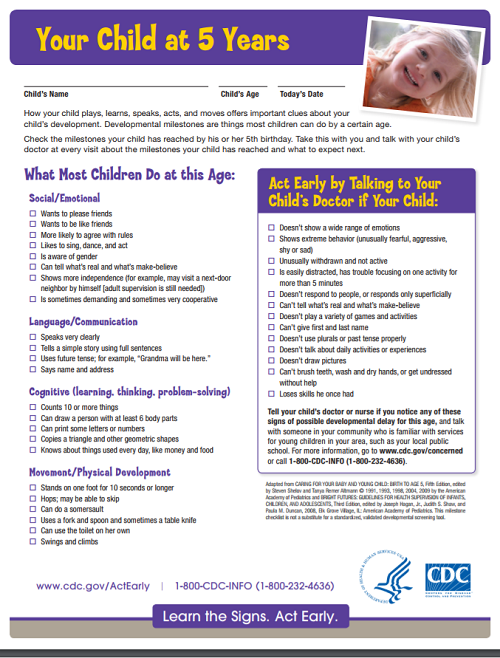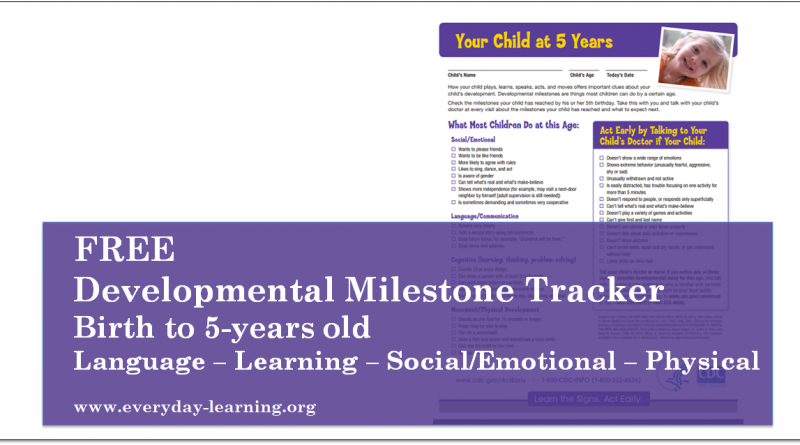CDC Milestone Tracker
When you homeschool your preschooler or kindergartner, it’s easy to second-guess yourself. All it takes is a well-meaning mother-in-law to bring up how Cousin Johnny could multiply numbers when they started school before all kinds of nagging self-doubts ensue.
Before you lose any sleep about how you might be royally messing up homeschooling, take a deep breath and keep reading.
The Centers for Disease Control and Prevention (CDC) recently released a FREE downloadable Developmental Milestone app for parents, early education teachers, childcare workers – or anyone interested in knowing if a child is growing up within usual expectations.
What makes this app so great is that it includes pictures and videos to help parents gauge where their child may fall on the developmental spectrum. Take these 2 adorable little girls that demonstrate how story telling skills change between the ages 4 and 5.
Using the app
Once you plug in your child’s birth date, the app will guide you through a series of developmental questions, for the ages of 2-months to 5-years, covering:
- Language and Communication skills
- Cognitive: Learning, Thinking, & Problem-solving skills
- Social and Emotional skills
- Movement and Physical skills
Each of the questions let you answer YES, NOT YET, or NOT SURE. You can even go back and complete checklists for younger years so you can have a bigger picture of your child’s developmental progression.
Once you complete the checklist, you’ll get a milestone summary along with Tips and Activities you can do to support your child’s growth and development.
Don’t diagnose
The CDC Milestone Tracker is a useful checklist tool to help parents – BUT it does not diagnose developmental problems in children.
What pediatricians and early childhood specialists know for certain is that “normal development” spans a range of abilities. Hitting (or not hitting) one milestone does not mean a child is “normal” (or delayed).
For example, some children are late talkers and don’t begin speaking single words until the age of 2, but then quickly progress to complete sentences after just a couple of months. Other children may begin babbling words at 8-months but then encounter difficulties with oral communication during the preschool years.
Tracking developmental milestones with an app like this is a good way to be aware of the range of “normal”. The app lets you include notes for each checklist item so you can share the information with your pediatrician during well-child check-ups, or if you think there may be a problem.

Using the Tips
The app has its limitations. For starters, it only offers checklists for up to the age of 5 and its suggested Tips and Activities are very general. Still, I find this app super-relevant for new homeschool families.
You see, while we absolutely want all children to become successful readers and to meet their full academic potential, it’s easy to get caught up in the comparison game. Even if Cousin Johnny knows 6 times 4 on the first day of kindergarten (which is actually beyond normal development for a 5-year old) and your kiddo is struggling to count to ten (which is the developmental milestone at 5), you still want to make sure your child isn’t missing other important developmental milestones in the social-emotional and physical domains.
Children develop at different rates. Unless there are significant and serious gaps in developmental milestones, it’s okay to take a break from a slightly lagging area while you put forth effort in another domain. So, rather than getting out the abacus and doing 5 math worksheets a day, you can choose to balance your homeschool day with other important activities, like learning how to skip and do somersaults.
Don’t want to download an app?
You can use the app on your laptop through the Apple iTunes platform. Or, you can find all the same information online at CDC’s Learn the Signs. Act Early. website.
Already concerned about a specific developmental disability?
Visit CDC’s Developmental Disabilities homepage for more information on conditions due to an impairment in physical, learning, language, or behavior areas, such as:
- Attention-Deficit/Hyperactivity Disorder
- Autism Spectrum Disorder
- Cerebral Palsy
- Fetal Alcohol Spectrum Disorders
- Fragile X Syndrome
- Hearing Loss
- Intellectual Disability (low IQ)
- Kernicterus
- Muscular Dystrophy
- Tourette Syndrome
- Vision Impairment




